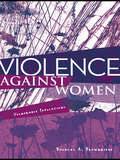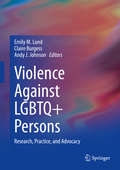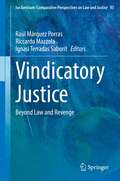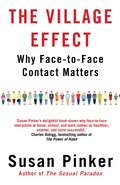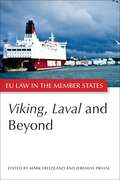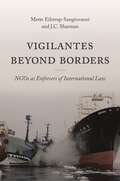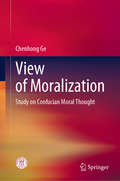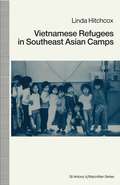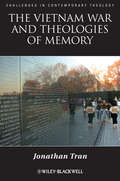- Table View
- List View
Violence Against Women, Hate and Law: Perspectives from Contemporary Scotland (Palgrave Hate Studies)
by Kim Barker Olga JuraszThis book presents the first academic study offering a holistic assessment of violence against women (VAW) in Scotland, both online and offline. In particular, it focuses on VAW, hate crime, and online forms of violence against women (OVAW). It critically assesses the gaps in the hate crime protections in Scots Law, focusing specifically on the absence of legal protections for VAW, OVAW, hate crime, and gender-based violence, and it includes international comparisons throughout. Given the current upsurge in the abuse of women, this book offers a holistic assessment of the phenomenon of VAW and makes the case for pressing law reform in Scotland, specifically for legal protections against VAW and OVAW to be included within Scots Law. The book contains not only research findings but also makes practical recommendations for law and policy reform in the areas of hate crime, VAW and OVAW. As such, it contributes to Scotland’s progressive and leading approach to tackling violence against women and girls.
Violence Against Women and Criminal Justice in Africa: Sexual Violence and Vulnerability (Sustainable Development Goals Series)
by Ashwanee Budoo-Scholtz Emma Charlene LubaaleThis book examines violence against women in Africa and criminal justice from the perspective of African scholars, practitioners and experts. As a global and long-standing issue, violence against women is gaining public visibility across the African continent with some states announcing a national crisis warranting immediate redress. At the global level, the elimination of all forms of violence against all women and girls forms a key part of United Nations Sustainable Development Goal 5: Gender Equality. Split across two volumes, these books present a comprehensive analysis of the latest research and theories, principles and practices of criminal justice systems, criminal justice accountability mechanisms, and the key challenges women face in their quest for justice on the African continent. This volume (II) focusses on sexual violence and vulnerable women’s access to justice in Africa. Volume I focusses on legislation and its impact, the limitations of criminal justice responses, and the cultural and social norms regarding access to justice. Together, they adopt a comparative approach that highlight gaps and good practices to provide a rich source of authoritative information for promoting an intra-African dialogue and cross-fertilization of ideas across the different criminal justice traditions in Africa. Both volumes seek to advance discussions on eliminating violence against women in Africa and speak to those interested in criminal justice, violence, gender studies and African legal studies.
Violence Against Women and Criminal Justice in Africa: Legislation, Limitations and Culture (Sustainable Development Goals Series)
by Emma Charlene Lubaale Ashwanee Budoo-ScholtzThis book examines violence against women in Africa and criminal justice from the perspective of African scholars, practitioners and experts. As a global and long-standing issue, violence against women is gaining public visibility across the African continent with some states announcing a national crisis warranting immediate redress. At the global level, the elimination of all forms of violence against all women and girls forms a key part of United Nations Sustainable Development Goal 5: Gender Equality. Split across two volumes, these books present a comprehensive analysis of the latest research and theories, principles and practices of criminal justice systems, criminal justice accountability mechanisms, and the key challenges women face in their quest for justice on the African continent. Volume I focusses on legislation and its impact, the limitations of criminal justice responses, and the cultural and social norms regarding access to justice. Volume II examines sexual violence and vulnerable women’s access to justice in Africa. They adopt a comparative approach that highlight gaps and good practices to provide a rich source of authoritative information for promoting an intra-African dialogue and cross-fertilization of ideas across the different criminal justice traditions in Africa. Both volumes seek to advance discussions on eliminating violence against women in Africa and speak to those interested in criminal justice, violence, gender studies and African legal studies.
Violence Against Women: Vulnerable Populations
by Douglas A. BrownridgeViolence Against Women: Vulnerable Populations investigates under-researched and underserved groups of women who are particularly vulnerable to violent victimization from an intimate male partner. In the past, there has been an understandable reluctance to address this issue to avoid stereotyping vulnerable groups of women. However, developments in the field, particularly intersectionality theory, which recognizes women’s diversity in experiences of violence, suggest that the time has come to make the study of violence in vulnerable populations a new sub-field in the area. As the first book of its kind, Violence Against Women: Vulnerable Populations identifies where violence on vulnerable populations fits within the field, develops a method for studying vulnerable populations, and brings vital new knowledge to the field through the analysis of original data (from three large-scale representative surveys) on eight populations of women who are particularly vulnerable to violence.
Violence Against Women: Vulnerable Populations
by Douglas A. BrownridgeViolence Against Women: Vulnerable Populations investigates under-researched and underserved groups of women who are particularly vulnerable to violent victimization from an intimate male partner. In the past, there has been an understandable reluctance to address this issue to avoid stereotyping vulnerable groups of women. However, developments in the field, particularly intersectionality theory, which recognizes women’s diversity in experiences of violence, suggest that the time has come to make the study of violence in vulnerable populations a new sub-field in the area. As the first book of its kind, Violence Against Women: Vulnerable Populations identifies where violence on vulnerable populations fits within the field, develops a method for studying vulnerable populations, and brings vital new knowledge to the field through the analysis of original data (from three large-scale representative surveys) on eight populations of women who are particularly vulnerable to violence.
Violence against Women: What Everyone Needs to Know® (What Everyone Needs to Know)
by Jacqui TrueViolence against women and girls (VAWG) is a longstanding problem that has increasingly come to the forefront of international and national policy debates and news: from the US reauthorization of the Violence against Women Act and a United Nations declaration to end sexual violence in war, to coverage of gang rapes in India, cyberstalking and "revenge porn", honor killings, female genital mutilation, and international trafficking. Yet, while we frequently read or learn about particular experiences or incidents of VAWG, we are often unaware of the full picture. Jacqui True, an internationally renowned scholar of globalization and gender, provides an expansive frame for understanding VAWG in this book. Among the questions she addresses include: What are we talking about when we discuss VAWG? What kinds of violence does it encompass? Who does it affect most and why? What are the risk factors for victims and perpetrators? Does VAWG occur at the same level in all societies? Are there cultural explanations for it? What types of legal redress do victims have? How reliable are the statistics that we have? Are men and boys victims of gender-based violence? What is the role of the media in exacerbating VAWG? And, what sorts of policy and advocacy routes exist to end VAWG? This volume addresses the current state of knowledge and research on these questions. True surveys our best understanding of the causes and consequences of violence against women in the home, local community, workplace, public, and transnationally. In so doing, she brings together multidisciplinary perspectives on the problem of violence against women and girls, and sets out the most promising policy and advocacy frameworks to end this violence.
Violence Against LGBTQ+ Persons: Research, Practice, and Advocacy
by Emily M. Lund Claire Burgess Andy J. JohnsonAs violence against LGBTQ+ persons continues to be a pervasive and serious problem, this book aims to inform mental health providers about the unique needs of LGBTQ+ survivors of interpersonal and structural violence. Individual chapters analyze unique aspects of violence against specific subpopulations of LGBTQ+ persons in order to avoid ineffective and sometimes simplistic one-size-fits-all treatment strategies. Among the topics covered: Macro Level Advocacy for Mental Health Professionals: Promoting Social Justice for LGBTQ+ Survivors of Interpersonal Violence Intimate Partner Violence in Women’s Same-Sex Relationships Violence Against Asexual PersonsInvisibility and Trauma in the Intersex CommunitySexual and Gender Minority Refugees and Asylum Seekers: An Arduous JourneySexual and Gender Minority Marginalization in Military ContextsNavigating Potentially Traumatic Conservative Religious Environments as a Sexual/Gender Minority Violence Against LGBTQ+ Persons prepares mental health professionals for addressing internalized forms of prejudice and oppression that exacerbate the trauma of the survivor, in order to facilitate healing, empowerment, healthy relationships, and resilience at the intersection of sexual orientation, gender identity, gender expression, and diverse social locations. This is a valuable reference for psychologists, social workers, counselors, nurses, mental health professionals, and graduate students, regardless of whether they are preparing for general practice, treatment of LGBTQ+ clients, or treatment of survivors and perpetrators of various forms of violence.
The Vinson Court: Justices, Rulings, and Legacy (ABC-CLIO Supreme Court Handbooks)
by Michal R. BelknapSpanning the years from 1946 until 1953, the Vinson Court made the legal transition from World War II to the Korean War, and the outspoken justices Felix Frankfurter and Hugo Black helped shape its legacy.The Vinson Court summons students and legal professionals to understand the impact and tensions of Fred Vinson's term as Chief Justice from 1946–1953. Court scholar Michal R. Belknap explores McCarthyism, the Cold War, racial segregation, and capital punishment from the Supreme Court's view. These controversies shaped the most important decision on presidential powers, restrictions on political expression, and a nasty conflict over the Rosenbergs.Significant rulings are reviewed, and the 12 justices on the Vinson Court including Felix Frankfurter and Hugo Black are introduced. Clashes were common between some of the Supreme Court's strongest personalities, and these are highlighted throughout the text. The court's legacy completes this powerful study of constitutional law.
Vindicatory Justice: Beyond Law and Revenge (Ius Gentium: Comparative Perspectives on Law and Justice #93)
by Raúl Márquez Porras Riccardo Mazzola Ignasi Terradas SaboritThis volume offers a new theoretical approach to the analysis of the law/revenge binary, and attempts to dismantle the common idea of revenge as lacking any legal, moral or rational dimension. In contrast, the book puts forward a model of a complex system of justice—which it terms 'vindicatory'—wherein vendetta constitutes an authorized action, the core of which does not (just) lie in vengeance but also in settlement procedures for peace—or 'composition.' The first part of the book ("Vindicatory Justice: Conceptual Analyses and Forerunners") seeks to identify the nature of vindicatory justice and to shed light on the structure of so-called vindicatory systems. In turn, the second part ("Mapping Vindicatory Justice") illustrates, using examples gathered from a range of sociolegal contexts, the dynamic relationship between composition and authorized revenge in vindicatory systems. Taken as a whole, the volume shows that applying a longue durée historical perspective to the study of revenge systems allows us to clearly recognize composition and authorized revenge as features of the same legal system, even though one of them may seem predominant (or more eye-catching) than the other in certain cultural settings.
The Village Effect: Why Face-to-face Contact Matters
by Susan PinkerMarrying the findings of the new field of social neuroscience together with gripping human stories, award-winning author and psychologist Susan Pinker explores the impact of face-to-face contact from cradle to grave, from city to Sardinian mountain village, from classroom to workplace, from love to marriage to divorce. Her results are enlightening and enlivening, and they challenge our assumptions. Most of us have left the literal village behind, and don't want to give up our new technologies to go back there. But, as Pinker writes so compellingly, we need close social bonds and uninterrupted face-time with our friends and families in order to thrive - even to survive. Creating our own 'village effect' can make us happier. It can also save our lives.
Viking, Laval and Beyond (EU Law in the Member States)
by Mark R Freedland Jeremias PrasslEU Law in the Member States is a new series dedicated to exploring the impact of landmark CJEU judgments and secondary legislation in legal systems across the European Union. Each book will be written by a team of generalist EU lawyers and experts in the relevant field, bringing together perspectives from a wide range of different Member States in order to compare and analyse the effect of EU law on domestic legal systems and practice.The first volume focuses on the uneasy relationship between the economic freedoms enshrined in Articles 49 and 56 TFEU and the right of workers to take collective action. This conflict has been at the forefront of EU labour law since the CJEU's much-discussed decisions in C-438/05 Viking and C-341/05 Laval, as well as the Commission's more recent attempts at legislative reforms in the failed Monti II Regulation. Viking, Laval and Beyond explores judicial and legislative responses to these measures in 10 Member States, and finds that the impact on domestic legal systems has been much more varied than traditional accounts of EU law would suggest.
Viking, Laval and Beyond (EU Law in the Member States)
by Mark Freedland Qc Hon Jeremias PrasslEU Law in the Member States is a new series dedicated to exploring the impact of landmark CJEU judgments and secondary legislation in legal systems across the European Union. Each book will be written by a team of generalist EU lawyers and experts in the relevant field, bringing together perspectives from a wide range of different Member States in order to compare and analyse the effect of EU law on domestic legal systems and practice.The first volume focuses on the uneasy relationship between the economic freedoms enshrined in Articles 49 and 56 TFEU and the right of workers to take collective action. This conflict has been at the forefront of EU labour law since the CJEU's much-discussed decisions in C-438/05 Viking and C-341/05 Laval, as well as the Commission's more recent attempts at legislative reforms in the failed Monti II Regulation. Viking, Laval and Beyond explores judicial and legislative responses to these measures in 10 Member States, and finds that the impact on domestic legal systems has been much more varied than traditional accounts of EU law would suggest.
Vigilantes beyond Borders: NGOs as Enforcers of International Law
by Mette Eilstrup-Sangiovanni J C SharmanHow and why NGOs are increasingly taking independent and direct action in global law enforcement, from human rights to the environment Nongovernmental organizations (NGOs) have generally served as advocates and service providers, leaving enforcement to states. Now, NGOs are increasingly acting as private police, prosecutors, and intelligence agencies in enforcing international law. NGOs today can be found investigating and gathering evidence; suing and prosecuting governments, companies, and individuals; and even catching lawbreakers red-handed. Examining this trend, Vigilantes beyond Borders considers why some transnational groups have opted to become enforcers of international law regarding such issues as human rights, the environment, and corruption, while others have not.Three factors explain the rise of vigilante enforcement: demand, supply, and competition. Governments commit to more international laws, but do a poor job of policing them, leaving a gap and creating demand. Legal and technological changes make it easier for nonstate actors to supply enforcement, as in the instances of NGOs that have standing to use domestic and international courts, or smaller NGOs that employ satellite imagery, big data analysis, and forensic computing. As the growing number of NGOs vie for limited funding and media attention, smaller, more marginal, groups often adopt radical strategies like enforcement.Looking at the workings of major organizations, including Amnesty International, Greenpeace, and Transparency International, as well as smaller players, such as Global Witness, the Sea Shepherd Conservation Society, and Bellingcat, Vigilantes beyond Borders explores the causes and consequences of a novel, provocative approach to global governance.
Vigilantes beyond Borders: NGOs as Enforcers of International Law
by Mette Eilstrup-Sangiovanni J C SharmanHow and why NGOs are increasingly taking independent and direct action in global law enforcement, from human rights to the environment Nongovernmental organizations (NGOs) have generally served as advocates and service providers, leaving enforcement to states. Now, NGOs are increasingly acting as private police, prosecutors, and intelligence agencies in enforcing international law. NGOs today can be found investigating and gathering evidence; suing and prosecuting governments, companies, and individuals; and even catching lawbreakers red-handed. Examining this trend, Vigilantes beyond Borders considers why some transnational groups have opted to become enforcers of international law regarding such issues as human rights, the environment, and corruption, while others have not.Three factors explain the rise of vigilante enforcement: demand, supply, and competition. Governments commit to more international laws, but do a poor job of policing them, leaving a gap and creating demand. Legal and technological changes make it easier for nonstate actors to supply enforcement, as in the instances of NGOs that have standing to use domestic and international courts, or smaller NGOs that employ satellite imagery, big data analysis, and forensic computing. As the growing number of NGOs vie for limited funding and media attention, smaller, more marginal, groups often adopt radical strategies like enforcement.Looking at the workings of major organizations, including Amnesty International, Greenpeace, and Transparency International, as well as smaller players, such as Global Witness, the Sea Shepherd Conservation Society, and Bellingcat, Vigilantes beyond Borders explores the causes and consequences of a novel, provocative approach to global governance.
Vigilance: My Life Serving America and Protecting Its Empire City
by Ray KellyTwo-time New York City police commissioner Ray Kelly opens up about his remarkable life, taking us inside fifty years of law enforcement leadership, offering chilling stories of terrorist plots after 9/11, and sharing his candid insights into the challenges and controversies cops face today.The son of a milkman and a Macy's dressing room checker, Ray Kelly grew up on New York City's Upper West Side, a middle-class neighborhood where Irish and Puerto Rican kids played stickball and tussled in the streets. He entered the police academy and served as a marine in Vietnam, living and fighting by the values that would carry him through a half century of leadership-justice, decisiveness, integrity, courage, and loyalty.Kelly soared through the NYPD ranks in decades marked by poverty, drugs, civil unrest, and a murder rate that, at its peak, spiked to over two thousand per year. Kelly came to be known as a tough leader, a fixer who could go into a troubled precinct and clean it up. That reputation catapulted him into his first stint as commissioner, under Mayor David Dinkins, where Kelly oversaw the police response to the 1993 World Trade Center bombing and spearheaded programs that would help usher in the city's historic drop in crime.Eight years later, in the chaotic wake of the 9/11 attacks, newly elected mayor Michael Bloomberg tapped Kelly to be NYC's top cop once again. After a decade working with Interpol, serving as undersecretary of the Treasury for enforcement, overseeing U.S. Customs, and commanding an international police force in Haiti, Kelly understood that New York's security was synonymous with our national security. Believing that the city could not afford to rely solely on "the feds," he succeeded in transforming the NYPD from a traditional police department into a resource-rich counterterrorism-and-intelligence force.In this vital memoir, Kelly reveals the inside stories of his life in the hot seat of "the capital of the world"-from the terror plots that nearly brought a city to its knees to his dealings with politicians, including Presidents Bill Clinton, George W. Bush, and Barack Obama as well as Mayors Rudolph Giuliani, Bloomberg, and Bill DeBlasio. He addresses criticisms and controversies like the so-called stop-question-and-frisk program and the rebuilding of the World Trade Center and offers his insights into the challenges that have recently consumed our nation's police forces, even as the need for vigilance remains as acute as ever.
Views of European Law from the Mountain: Liber Amicorum for Piet Jan Slot
by M. Bulterman, L. Hancher, A. McDonnell and H. SevensterPiet Jan Slot is one of a notable group of innovators who have greatly elucidated the role of law in the construction of European integration. His retirement this year from the Law Faculty at Leiden University has occasioned this festschrift, in which forty-six colleagues, past and present, recognize his many sterling contributions and engage with issues central to his work. Many of them focus on aspects of European competition law, while others extend his preoccupations with such fields as environmental regulation, energy, transport, and the interfaces of European law with both Member State law and international (global) law. Ranging from historical tendencies to emerging trends and possibilities, the authors explore dozens of relevant topics, including the following: harmonization of EU law; progress of the concept of technical barriers; economic justifications and the fundamental freedoms; the Keck dichotomy between product requirements and selling arrangements; private antitrust enforcement in an international context; retail price maintenance; competitors role in the public enforcement of the state aid regime; scope of judicial review of sanctions in competition law; competition and security of supply; ownership unbundling; proliferation of EU regulatory agencies; and the influence of the ECJ on the interpretation of the ECHR. Conscious of Slot's ability to identify and analyse the crucial issues of a complicated matter and express them in a clear way adequately attuned to the listener, the authors tackle some of the most complex areas in European law. Although, like Slot, they consider European integration as a value that should be respected and fostered, by no means do they uncritically accept European law or the way it is made. They carry on Slot's work in interpreting and applying European law to search for solutions that maintain, develop and enrich the legal order established by the various European Treaties. This challenging and absorbing book offers everyone interested a rich selection of topical as well as controversial issues in a number of areas of European law. It is a fitting tribute to the diversity and reach of Slot's contribution to these fields as an academic and practitioner over a period of some forty years.
View of Moralization: Study on Confucian Moral Thought
by Chenhong GeThis book summarizes the author’s extensive research on Confucian morality issues and focuses on elaborating the extremely important and unique role of moral thought in Confucian ideology. The book shares the author’s own standpoints on a range of issues – including where moral thoughts originated, what the major principles are, and what methods were adopted in Confucianism – to form a comprehensive and in-depth interpretation, and help readers achieve a better understanding.Moreover, the book focuses on the similarities and differences between Chinese and western cultures and presents an in-depth analysis of the differences and roots regarding various aspects, including Chinese and western historical development paths, thoughts and cultures, national spirits, national mentalities, and social governance models. The formation of either culture has its own practical reasons and historical roots. The book represents a major contribution, helping readers understand the similarities and differences between Chinese and western cultures and social civilizations, enabling them to integrate and learn from Chinese and western cultures, and promoting a better development for Chinese society and the international community alike. Combining detailed data and an approachable style, it contributes to the legacy of Confucianism by applying a critical attitude. The author thinks out of the box in terms of theoretical analysis and studies on certain issues. As such, the book will be of great academic value in terms of studying China’s ideological culture, especially its morality culture, and will benefit scholars and research institutions alike.
A View from Two Benches: Bob Thomas in Football and the Law
by Doug FeldmannWhether in football or in the law, Illinois Supreme Court Justice Robert Thomas has always had the "best view from the bench."Bob Thomas got his start in football at the University of Notre Dame, kicking for the famed "Fighting Irish" in the early 1970s. Claimed off waivers by the Chicago Bears in 1975, Thomas helped to take the franchise from their darkest days to their brightest. Yet, on the cusp of the team's greatest moment, he was struck with a shocking blow that challenged his fortitude.In this dramatic retelling of Bob Thomas's fascinating life, renowned sports writer Doug Feldmann shows how neither football nor the law was part of Thomas's dreams while growing up the son of Italian immigrants in Rochester, New York, in the 1960s. Chasing excellence on both the gridiron and in the courtroom, however, would require resilience in ways he could not have imagined.As A View from Two Benches shows us, Bob Thomas reached the top of two separate and distinct professions, guided by a bedrock of faith that has impacted his decisions and actions as both a football player and a judge, helping him navigate the peaks and valleys of life. As Doug Feldmann reveals, Bob Thomas has always stayed true to the values he learned in his earliest days.Doug Feldmann's rich biography of an accomplished kicker and a proud justice of the law shows us that determination and resilience go a long way to a successful and impactful life.
The View from Here: On Affirmation, Attachment, and the Limits of Regret
by R. Jay WallaceMust we always later regret actions that were wrong for us to perform at the time? Can there ever be good reason to affirm things in the past that we know were unfortunate? In this original work of moral philosophy, R. Jay Wallace shows that the standpoint from which we look back on our lives is shaped by our present attachments-to persons, to the projects that imbue our lives with meaning, and to life itself. Through a distinctive "affirmation dynamic", these attachments commit us to affirming the necessary conditions of their objects. The result is that we are sometimes unable to regret events and circumstances that were originally unjustified or otherwise somehow objectionable. Wallace traces these themes through a range of examples. A teenage girl makes an ill-advised decision to conceive a child - but her love for the child once it has been born makes it impossible for her to regret that earlier decision. The painter Paul Gauguin abandons his family to pursue his true artistic calling (and eventual life project) in Tahiti--which means he cannot truly regret his abdication of familial responsibility. The View from Here offers new interpretations of these classic cases, challenging their treatment by Bernard Williams and others. Another example is the "bourgeois predicament": we are committed to affirming the regrettable social inequalities that make possible the expensive activities that give our lives meaning. Generalizing from such situations, Wallace defends the view that our attachments inevitably commit us to affirming historical conditions that we cannot regard as worthy of being affirmed--a modest form of nihilism.
The View from Here: On Affirmation, Attachment, and the Limits of Regret
by R. Jay WallaceMust we always later regret actions that were wrong for us to perform at the time? Can there ever be good reason to affirm things in the past that we know were unfortunate? In this original work of moral philosophy, R. Jay Wallace shows that the standpoint from which we look back on our lives is shaped by our present attachments-to persons, to the projects that imbue our lives with meaning, and to life itself. Through a distinctive "affirmation dynamic", these attachments commit us to affirming the necessary conditions of their objects. The result is that we are sometimes unable to regret events and circumstances that were originally unjustified or otherwise somehow objectionable. Wallace traces these themes through a range of examples. A teenage girl makes an ill-advised decision to conceive a child - but her love for the child once it has been born makes it impossible for her to regret that earlier decision. The painter Paul Gauguin abandons his family to pursue his true artistic calling (and eventual life project) in Tahiti--which means he cannot truly regret his abdication of familial responsibility. The View from Here offers new interpretations of these classic cases, challenging their treatment by Bernard Williams and others. Another example is the "bourgeois predicament": we are committed to affirming the regrettable social inequalities that make possible the expensive activities that give our lives meaning. Generalizing from such situations, Wallace defends the view that our attachments inevitably commit us to affirming historical conditions that we cannot regard as worthy of being affirmed--a modest form of nihilism.
The Vietnam War and Theologies of Memory: Time and Eternity in the Far Country (Challenges in Contemporary Theology #21)
by Jonathan TranThe Vietnam War and Theologies of Memory develops a theological analysis of the American war in Vietnam and constructs a Christian account of memory in relation to this tragic conflict. An elegantly written reflection of memory and forgiveness, this unique work explores the ecclesial practice of memory in relation to the American war in Vietnam Questions how and why we choose to remember atrocity, and asks whether it is ever ethical to simply forget Explores the theological categories of time and eternity, and the ideas of thinkers including Aquinas, Augustine, and Barth Reveals broader insights about history, memory, and redemption Resonates beyond the field of theological inquiry by offering a broader analysis of war entirely relevant to our time
The Vietnam War and International Law, Volume 4: The Concluding Phase
by Richard A. FalkThis concluding volume of The Vietnam War and International Law focuses on the last stages of America's combat role in Indochina. The articles in the first section deal with general aspects of the relationship of international law to the Indochina War. Sections II and III are concerned with the adequacy of the laws of war under modern conditions of combat, and with related questions of individual responsibility for the violation of such laws. Section IV deals with some of the procedural issues related to the negotiated settlement of the war. The materials in Section V seek to reappraise the relationship between the constitutional structure of the United States and the way in which the war was conducted, while the final section presents the major documents pertaining to the end of American combat involvement in Indochina. A supplement takes account of the surrender of South Vietnam in spring 1975.Contributors to the volume—lawyers, scholars, and government officials—include Dean Rusk, Eugene V. Rostow, Richard A. Falk, John Norton Moore, and Richard Wasserstrom.Originally published in 1976.The Princeton Legacy Library uses the latest print-on-demand technology to again make available previously out-of-print books from the distinguished backlist of Princeton University Press. These editions preserve the original texts of these important books while presenting them in durable paperback and hardcover editions. The goal of the Princeton Legacy Library is to vastly increase access to the rich scholarly heritage found in the thousands of books published by Princeton University Press since its founding in 1905.
The Vietnam War and International Law, Volume 3: The Widening Context
by Richard A. FalkIssues of the war that have provoked public controversy and legal debate over the last two years—the Cambodian invasion of May-June 1970, the disclosure in November 1969 of the My Lai massacre, and the question of war crimes—are the focus of Volume 3. As in the previous volumes, the Civil War Panel of the American Society of International Law has endeavored to select the most significant legal writing on the subject and to provide, to the extent possible, a balanced presentation of opposing points of view. Parts I and II deal directly with the Cambodian, My Lai, and war crimes debates. Related questions are treated in the rest of the volume: constitutional debate on the war; the distribution of functions among coordinate branches of the government; the legal status of the insurgent regime in the struggle for control of South Vietnam; prospects for settlement without a clear-cut victory; and Vietnam's role in general world order. The articles reflect the views of some forty contributors: among them, Jean Lacouture, Henry Kissinger, John Norton Moore, Quincy Wright, William H. Rhenquist, and Richard A. Falk.Originally published in 1972.The Princeton Legacy Library uses the latest print-on-demand technology to again make available previously out-of-print books from the distinguished backlist of Princeton University Press. These editions preserve the original texts of these important books while presenting them in durable paperback and hardcover editions. The goal of the Princeton Legacy Library is to vastly increase access to the rich scholarly heritage found in the thousands of books published by Princeton University Press since its founding in 1905.
Vietnam Tax Guide: Domestic Fiscal System and International Treaties
by Lorenzo RiccardiVietnam is one of the main developing countries experiencing rapid growth in East Asia. As part of ASEAN and strategically located near China and the Mekong region, Vietnam is considered a leading market between Asian and South Asian countries. Its fiscal system has recently been reformed in order to better align rules with the country’s economic development. Vietnam grants tax incentives and fiscal holidays to foreign investors and has concluded a significant number of double taxation treaties with other nations. This book describes in detail Vietnam’s complex tax system and policies, as well as major bilateral treaties in which Vietnam has entered into using country-by-country analysis.



